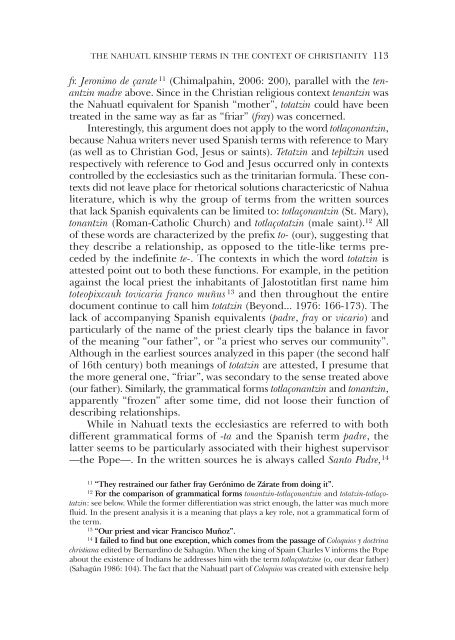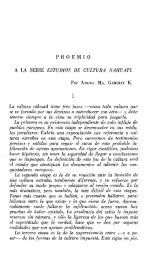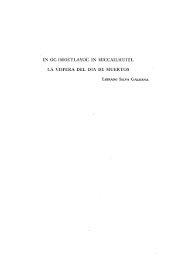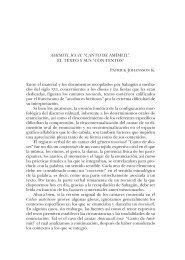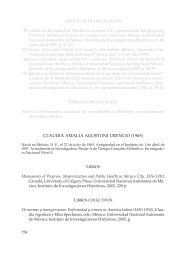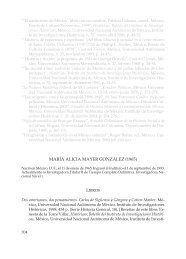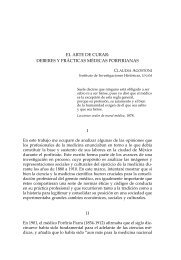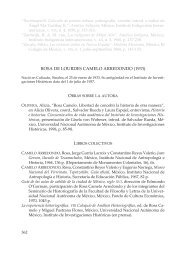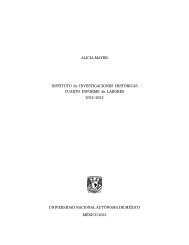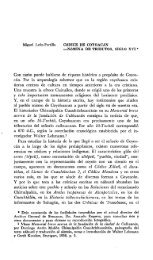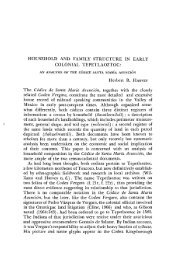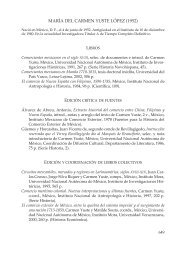“HOLY FAMILY”. THE NAHUATL KINSHIP TERMS IN THE ...
“HOLY FAMILY”. THE NAHUATL KINSHIP TERMS IN THE ...
“HOLY FAMILY”. THE NAHUATL KINSHIP TERMS IN THE ...
You also want an ePaper? Increase the reach of your titles
YUMPU automatically turns print PDFs into web optimized ePapers that Google loves.
The Nahuatl kinship terms in the context of Christianity 113<br />
fr. Jeronimo de çarate 11 (Chimalpahin, 2006: 200), parallel with the tenantzin<br />
madre above. Since in the Christian religious context tenantzin was<br />
the Nahuatl equivalent for Spanish “mother”, totatzin could have been<br />
treated in the same way as far as “friar” (fray) was concerned.<br />
Interestingly, this argument does not apply to the word totlaçonantzin,<br />
because Nahua writers never used Spanish terms with reference to Mary<br />
(as well as to Christian God, Jesus or saints). Tetatzin and tepiltzin used<br />
respectively with reference to God and Jesus occurred only in contexts<br />
controlled by the ecclesiastics such as the trinitarian formula. These contexts<br />
did not leave place for rhetorical solutions charactericstic of Nahua<br />
literature, which is why the group of terms from the written sources<br />
that lack Spanish equivalents can be limited to: totlaçonantzin (St. Mary),<br />
tonantzin (Roman-Catholic Church) and totlaçotatzin (male saint). 12 All<br />
of these words are characterized by the prefix to- (our), suggesting that<br />
they describe a relationship, as opposed to the title-like terms preceded<br />
by the indefinite te-. The contexts in which the word totatzin is<br />
attested point out to both these functions. For example, in the petition<br />
against the local priest the inhabitants of Jalostotitlan first name him<br />
toteopixcauh tovicaria franco muñus 13 and then throughout the entire<br />
document continue to call him totatzin (Beyond... 1976: 166-173). The<br />
lack of accompanying Spanish equivalents (padre, fray or vicario) and<br />
particularly of the name of the priest clearly tips the balance in favor<br />
of the meaning “our father”, or “a priest who serves our community”.<br />
Although in the earliest sources analyzed in this paper (the second half<br />
of 16th century) both meanings of totatzin are attested, I presume that<br />
the more general one, “friar”, was secondary to the sense treated above<br />
(our father). Similarly, the grammatical forms totlaçonantzin and tonantzin,<br />
apparently “frozen” after some time, did not loose their function of<br />
describing relationships.<br />
While in Nahuatl texts the ecclesiastics are referred to with both<br />
different grammatical forms of -ta and the Spanish term padre, the<br />
latter seems to be particularly associated with their highest supervisor<br />
—the Pope—. In the written sources he is always called Santo Padre, 14<br />
11<br />
“They restrained our father fray Gerónimo Gernimo de Zárate zrate from doing it”.<br />
12<br />
For the comparison of grammatical forms tonantzin-totlaçonantzin and totatzin-totlaçotatzin:<br />
see below. While the former differentiation was strict enough, the latter was much more<br />
fluid. In the present analysis it is a meaning that plays a key role, not a grammatical form of<br />
the term.<br />
13<br />
“Our priest and vicar Francisco Muo”. Muñoz”.<br />
14<br />
I failed to find but one exception, which comes from the passage of Coloquios y doctrina<br />
christiana edited by Bernardino de Sahagún. When the king of Spain Charles V informs the Pope<br />
about the existence of Indians he addresses him with the term totlaçotatzine (o, our dear father)<br />
(Sahagún 1986: 104). The fact that the Nahuatl part of Coloquios was created with extensive help


